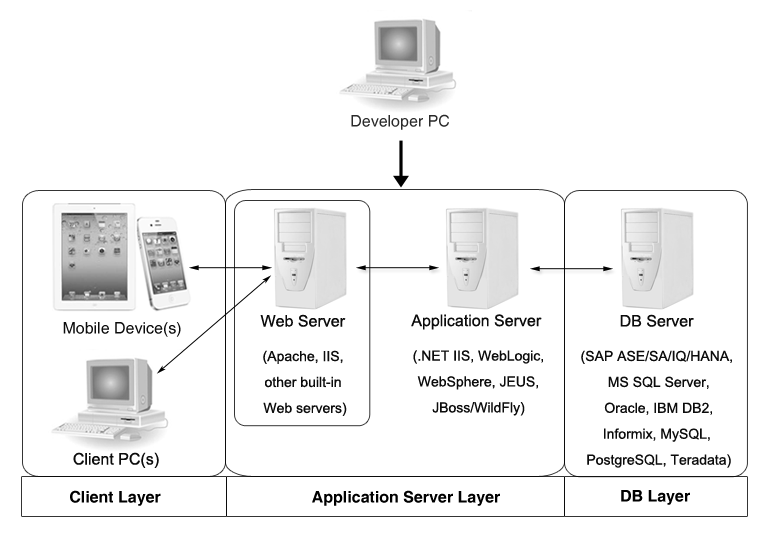Appeon PowerServer works with standard n-tier architecture. Each tier serves a specific purpose in the architecture, though it may not necessarily reside in the same physical machine. For example, the Web server, application server and database server can reside in one machine or in different machines. A single tier may also be spread across multiple physical machines. For example, the application server can consist of a cluster of PowerServer computers to provide load balancing and failover.
PowerServer applications deploy to the standard n-tier architecture - the client tier, middle tier (application server), and data tier (database) are logically separated. Each tier should have appropriate PowerServer Components and/or third-party software installed according to its role within the architecture. The following table briefly lists the tiers, roles, their purposes and the required Appeon/third-party software.
|
Tier |
Role |
Purpose |
PowerServer component |
Third-party Software |
|---|---|---|---|---|
|
Client tier |
Mobile Device |
Runs the PowerServer native mobile applications. |
Appeon Workspace (Optional) |
None |
|
Client PC |
Runs the PowerServer Web applications in Web browsers. |
Appeon Xcelerator plug-in |
Microsoft Internet Explorer, Microsoft Edge, Mozilla Firefox, Google Chrome, or Opera |
|
|
Developer PC |
Developer PC |
Deploys your PowerBuilder application to the server. |
PowerServer Toolkit |
PowerBuilder |
|
Middle tier |
Web Server |
Responds incoming requests from the client tier, and dispatches requests to the application server. Hosts the presentation layer of the deployed Web applications. |
PowerServer Web Component |
WebLogic HTTP Server or any WebLogic-compatible Web server |
|
Application Server |
Hosts the DataWindows of the PowerServer deployed applications, and provides the necessary run-time services to the deployed applications, such as DataWindow retrieval and update, Embedded SQLs, dynamic SQLs, security authentication etc. PowerServer application middle-tier can invoke Java components, external DLL functions, and C++ components. Furthermore, it supports Web Services for the most flexibility integrating with J2EE and .NET. |
PowerServer |
WebLogic Server |
|
|
Data tier |
Database Server |
Hosts the application database. |
None |
JDBC-compliant RDBMS supported by PowerServer. Please see Database server requirements for more information. |
-
Client Tier
Mobile device: The mobile application client layer is implemented using universal C++ libraries and JavaScript libraries. The C++ libraries render the mobile-style UI and provide interface for calling the device native features, information and hardware (camera, GPS, etc.), and support accessing the client/offline database and running the offline application. The JavaScript libraries support the PowerScript or UI logic coded in the Window object, user object (including NVOs), menu object and any other visual objects. These client libraries are automatically included in Appeon Workspace or the packaged mobile app.
Client PC: The Web application client layer consists of two plug-ins and some C++/JavaScript libraries which are originally built into PowerServer Web Component and then automatically downloaded to the client when the application is run for the first time. The two plug-ins manage the download and caching of the Web application and also act as the bridge to interact between the C++/JS libraries and the Web page. The C++/JS libraries render the PowerBuilder-style Web graphical user interface in the Web browsers.
-
Middle Tier
The middle tier, which hosts the business logic, is implemented with J2EE or .NET components. These components execute the DataWindows, Embedded SQLs, and dynamic SQLs of the deployed application. The middle tier deploys to the Java or .NET compliant PowerServer, leveraging dozens of many-years of investments in DataWindows and other business logic.
-
Data Tier
The database stores the raw data for the application and stored procedures, if any. The existing database from the PowerBuilder application can be simply re-used without modification so long as it is a PowerServer-certified database.



